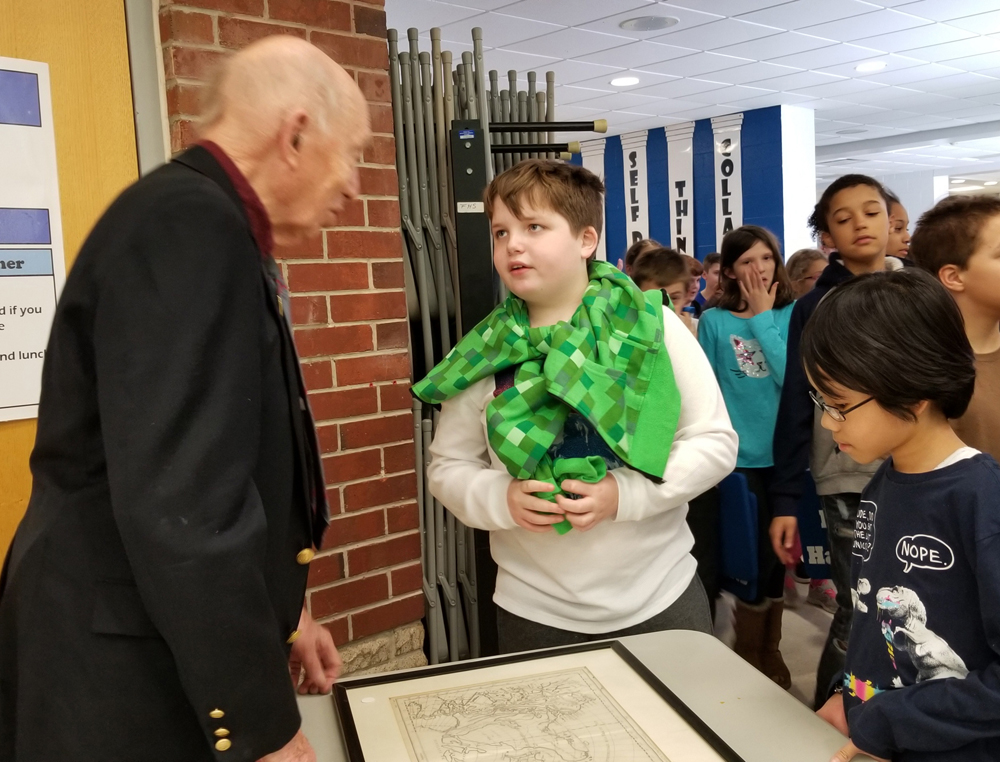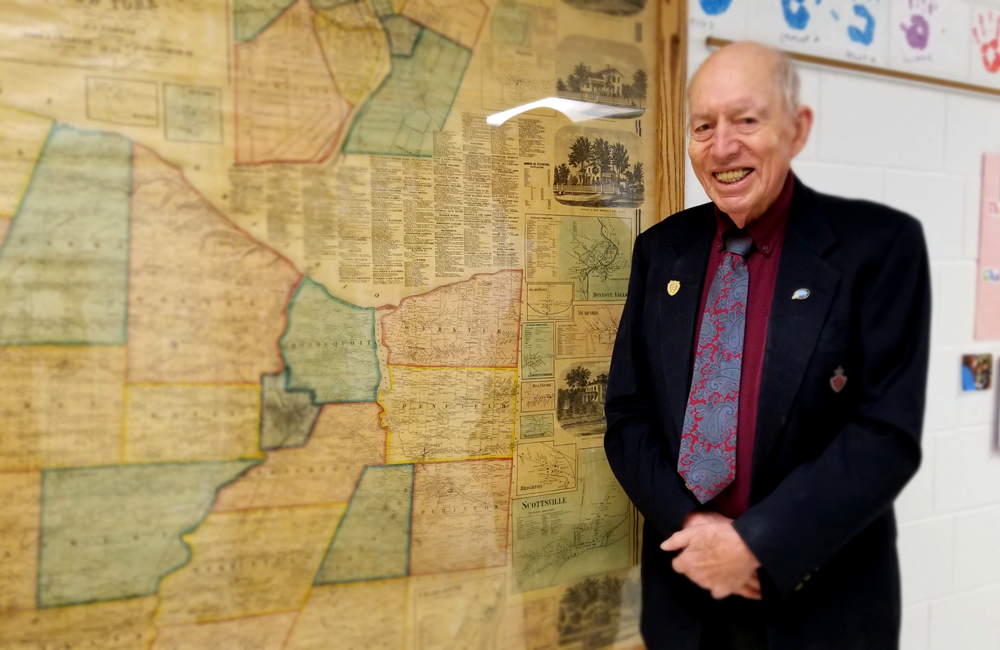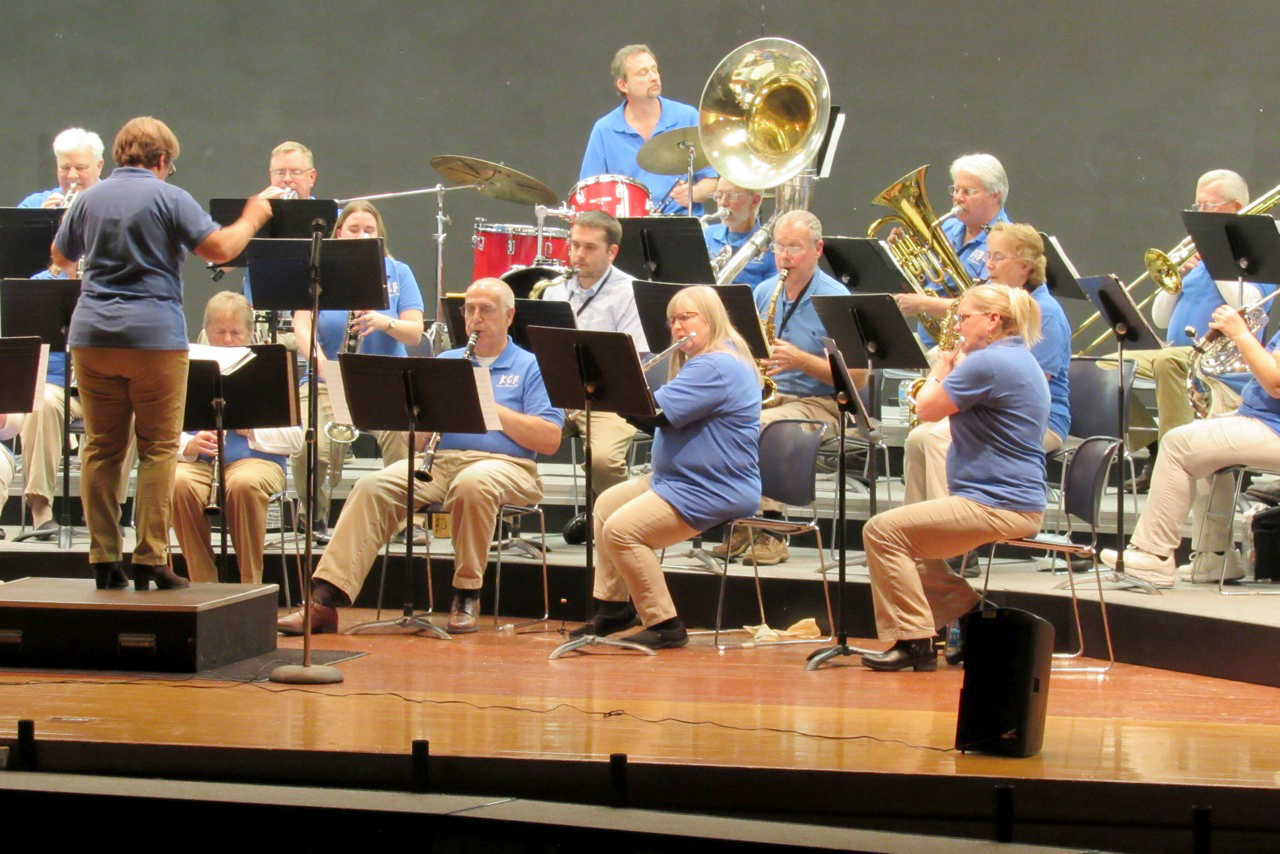Bill Andrews addresses Hill School students about history

Proving the past is not dead; it enriches a living future
Bill Andrews was apprehensive as he was about to address the fourth- and fifth-graders at Brockport’s Hill School. “I was nervous about talking to kids,” he said in an interview later. “I had never talked to elementary school students.”
It was February 13. He was there to dedicate the 24 framed historic maps which were hung in the school’s second floor hallway prior to 2015. The maps were from his private collection and were on indefinite loan at the request of then-principal, Sean Bruno. Bill came to dedicate the maps as a permanent gift to Hill School and he brought a few more to add to them. Since 1954, Bill has been collecting maps from different countries all over the world, including throughout the U.S. and local territories. (See the 1858 Monroe County map in photo).
In his decades-long career at The College at Brockport as Political Science Professor, now emeritus, Dr. William G. Andrews, Ph.D. has given a lifetime of scholarly lectures to college students. Retired 23 years ago, he now stood in the Hill School cafeteria, looking out at about 220 fourth-graders as he spoke. The second presentation had about 250 fifth-graders.
Bill had come with a written script, but was soon at ease as students engaged him with questions and their comments.
“It was a great experience. I loved it,” Bill said when it was over. “They were very attentive and did not seem at all restless.” At the end of each session, Bill stood at a table where he placed a map for students to view while exiting. Several stopped and talked with Bill (see photo).
Passing history on to a new generation
Bill’s written words at the Hill School event, and all the participation in the assembly, suggest a theme of “life regenerating itself.” “I enjoyed collecting maps,” Bill said about his vast collection in an interview. “At my age, I am thinking ‘What’s going to happen to those maps?’” He named other historic items which he had given to other institutions. Collections he has enjoyed for a lifetime are being passed on for others to experience in their lifetime.
In fact, in Bill’s brief message, he was passing on to the students his life’s experience of enjoying history. That enjoyment took on new life for him after retiring from college. Near the beginning of his remarks, he said:
“I have studied history all my life. But since I retired from college teaching 23 years ago, I have become involved with history in many new ways. My experience may suggest to you ways that you can become so involved in the years to come.”
He continued with humor about retired life.
“When I retired, I decided that I would not sit around all day gathering dust and annoying my wife. I would try to be useful in our community. My lifelong interest in history became my entry into the civic life of this community. I became the official Village Historian and a member of the Village’s Historic Preservation Board and the Town’s Landmarks Advisory Committee.”
History: The past helps to understand who we are now
Bill’s view about history is a good lesson for young and old who may think history is about events and people locked in a departed past. He said, “History is important for many reasons. We cannot understand fully who we are without knowing our past. Everyone is formed in some sense by their past and the past of their community.” He essentially affirmed this article’s sub-title: “The past is not dead; it enriches a living future.”
“Composting” came first, setting the theme
This school assembly also had students teaching students. The “Green Team” began the assembly with a skit on composting. Students were told about the importance of saving disposed organic material such as leaves, vegetable peels, egg shells, and coffee grounds on a pile or bin and letting it decompose. The compost is mixed with soil to enrich it and suppress plant diseases and pests; newly planted flowers and other vegetation thrive without harmful chemicals. In a vividly humorous way, the Green Team’s presentation introduced the implied theme of “life regenerating itself.”
Attitudes about learning instilled by Hill School’s principal and teachers
The general conduct of the assembly and the students’ behavior must be attributed to principal Brandon Broughton, the teachers, and the unseen parents. Mr. Broughton addressed the students to start the program. He asked how many had seen the maps on the second floor (show of hands). He went on to say (paraphrased), ‘We are thankful to Dr. Andrews and honored to have him here to talk about history and the maps. I know you’ll be on your best behavior.” Showing confidence in the students, he added, “The teachers are dismissed during the program. I know your students are so well-behaved you won’t need to stay here.” The behavior of the students showed respect for authority and learning skills of curiosity, inquiry, and dialogue – suggesting a rich future of lifelong learning.
Students teach history to adults
Throughout his talk, Bill cited all the local resources that “teach us about our past.” Besides maps, he said, there are history books, biographies, genealogies on family history. He reviewed all of the museums and historic structures in the Brockport area.
Among many kinds of museums in the community, Bill named the Morgan-Manning House, calling it “an historical monument to perhaps Brockport’s greatest family, the Morgans.” Fourth-grade students tour the house as part of the New York State history curriculum.
Christopher Albrecht, a Hill School teacher, has organized Morgan-Manning programs in which his former students, some now in Middle School, teach some aspect of history to the adults. Many in the audience raised their hands when asked if they had done that. “The idea was totally different from anything Morgan-Manning House had done,” Bill told his audience. “And, it has worked out splendidly. (The adults) love to learn history from children. They pack the room and applaud enthusiastically.”
“So, you see,” Bill said in conclusion, “there are many ways to learn about history, and many ways you can be involved in making history real for other people. The maps in your halls are only one small way, but they are a start. Make good use of them.”




